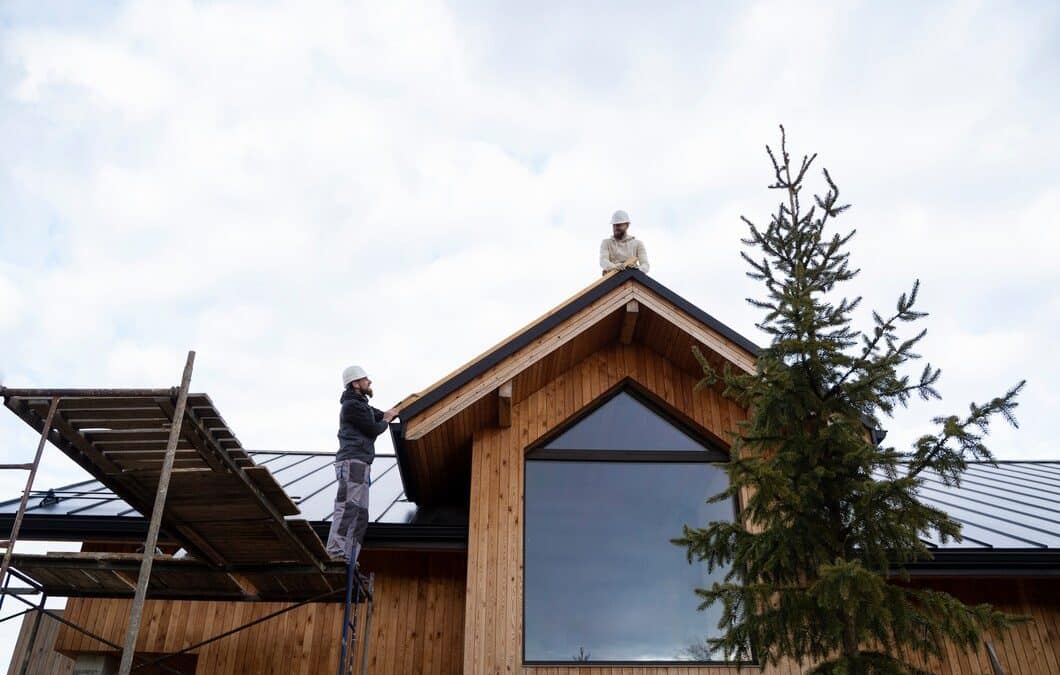Roof installation involves various risks, making it essential for businesses to follow strict safety protocols. Ensuring a secure work environment during roofing projects helps protect workers, avoid accidents, and complete projects efficiently. By adhering to safety guidelines, businesses can minimize disruptions and maintain a positive reputation.
One of the main concerns during roof installation is the safety of workers. Proper training and equipment usage are critical in preventing falls and other accidents. Implementing these safety measures helps create a safe working environment on the rooftop.
Additionally, using tools and equipment correctly is vital for a successful roofing project. Misusing tools can lead to accidents, injuries, and project delays. Ensuring that all team members understand how to use the equipment is essential for smooth operations.
Various environmental hazards, such as weather conditions and debris, can pose additional risks during roof installation. Identifying and mitigating these hazards is crucial for maintaining a safe workspace. Being prepared for environmental challenges helps prevent accidents and ensures the project stays on track.
Finally, having clear emergency procedures and first aid plans in place is essential for dealing with any incidents that may occur. Properly trained personnel and well-established protocols can make a significant difference in handling emergencies quickly and effectively.
By following these safety protocols, businesses can ensure a smooth and secure roof installation process. These measures protect workers, reduce accidents, and contribute to the overall success of roofing projects.
Ensuring Worker Safety on the Rooftop
Worker safety is a top priority during roof installation. To ensure a safe working environment, we must start with proper training. Workers should understand how to use safety equipment like harnesses, safety nets, and guardrails. Training helps prevent falls, which are a leading cause of injuries on rooftops.
We should also establish clear safety protocols. These protocols include maintaining a clean and organized work area. Tools and materials should be stored safely to avoid trips and falls. Keeping the workspace organized makes it easier to move around and reduces the risk of accidents.
Another important aspect of worker safety is communication. Workers should have a reliable way to communicate with each other. This can be done using hand signals or radios. Good communication helps everyone stay aware of their surroundings and reduces the risk of accidents.
Regular inspections of safety equipment are vital. Check harnesses, ladders, and guardrails for wear and tear. Faulty equipment should be repaired or replaced immediately to maintain a safe working environment.
Implementing these safety measures helps keep workers safe on the rooftop. Proper training, clear protocols, good communication, and regular equipment inspections are essential components of a safe roofing project.
Proper Use of Tools and Equipment
Using tools and equipment correctly is essential for a successful roofing installation. First, we must ensure that all workers are trained in the proper use of tools. This training includes how to handle power tools, ladders, and other equipment safely.
Labeling and organizing tools can also help. Workers should know where each tool is stored and how to access it quickly. An organized tool area minimizes the time spent searching for tools and reduces the risk of accidents.
It’s also crucial to inspect tools regularly. Check for any damage or wear that could make them unsafe to use. Damaged tools should be repaired or replaced immediately to prevent accidents.
Personal protective equipment (PPE) is another important consideration. Workers should wear appropriate PPE, such as gloves, safety glasses, and hard hats. This equipment helps protect against injuries from tools and debris.
Additionally, we should follow the manufacturer’s instructions for all equipment. These instructions provide important safety information and guidelines for proper use. Ignoring these instructions can lead to accidents and injuries.
By taking these steps, we can ensure the proper use of tools and equipment on the job site. Training, organization, inspection, and PPE are key elements in maintaining a safe and efficient roofing project.
Safety Measures for Environmental Hazards
Environmental hazards can significantly impact the safety of our roofing projects. One critical factor to consider is weather conditions. We should always check the weather forecast before starting any roofing work. High winds, rain, or extreme heat can create dangerous conditions on the roof. If the weather poses a risk, it’s best to postpone work until it’s safe to proceed.
Debris on the rooftop is another hazard. Loose materials, tools, and other objects can trip workers and cause falls. We must keep the rooftop clean and free of unnecessary items. Regularly sweeping the work area helps prevent accidents and ensures a safe environment.
We should also be aware of the materials we use. Some roofing materials can be hazardous if not handled correctly. For example, certain adhesives and sealants can be toxic if inhaled or if they come into contact with skin. We must use these materials in well-ventilated areas and wear appropriate personal protective equipment (PPE) to avoid health risks.
Lastly, protecting against electrical hazards is crucial. Power lines near the roof can pose a significant danger to workers. We should always identify and avoid any electrical hazards before starting the project. Using insulated tools and maintaining a safe distance from power lines reduces the risk of electrical accidents.
By taking these precautions, we can minimize environmental hazards and ensure a safer roofing project. Being aware of weather conditions, keeping the workspace clean, handling materials safely, and avoiding electrical hazards are vital steps in protecting our team.
Emergency Procedures and First Aid
Having clear emergency procedures and first aid plans is essential for handling any incidents that may occur during roof installation. One important step is to establish a clear emergency communication plan. All workers should know how to call for help and report an emergency. This might include using radios or a designated phone system.
We should also have a well-stocked first aid kit readily available on the job site. The kit should include items like bandages, antiseptics, and pain relievers. Knowing where the first aid kit is located and how to use its contents is crucial for quickly addressing minor injuries.
Training workers in basic first aid and CPR is another vital step. In the event of an injury, trained workers can provide immediate assistance while waiting for professional medical help. This can make a significant difference in the outcome of an emergency situation.
Additionally, we need to have clear evacuation plans. In case of a severe accident or hazardous condition, workers should know the fastest and safest way to leave the roof. Regularly practicing evacuation drills ensures everyone is prepared in an emergency.
Lastly, documenting all incidents and near-misses helps us identify safety improvements. By analyzing these reports, we can adjust our protocols and reduce the risk of future accidents.
Having well-defined emergency procedures and first aid plans keeps our team safe and prepared. Clear communication, accessible first aid supplies, proper training, evacuation plans, and incident documentation are key components of effective emergency management.
Final Thoughts
Maintaining strict safety protocols during roof installation is crucial for protecting our workforce and ensuring successful projects. Each of the discussed areas—ensuring worker safety on the rooftop, proper use of tools and equipment, managing environmental hazards, and having clear emergency procedures—plays a vital role in creating a safe work environment. By following these guidelines, we help prevent accidents and injuries, contributing to the overall efficiency and success of our roofing tasks.
Safety is a shared responsibility, and keeping our team well-trained and prepared is essential. Taking proactive measures can save lives and prevent costly delays. Regularly reviewing and updating our safety protocols ensures we stay compliant with industry standards and best practices.
At Mike Huddleston Roofing Systems, we prioritize the safety of our workers and the quality of our work. If you need professional roofing services with a commitment to safety, contact us today. Let us help you complete your roofing projects safely and efficiently.

